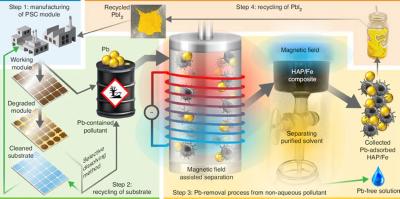New approach uses crown ethers to improve perovskite solar cell stability
Researchers from EPFL, Universität Tübingen and University of Fribourg, led by Professor Michael Grätzel at EPFL's School of Basic Sciences, used a novel method with multimodal host-guest complexation to significantly improve the stability of perovskite solar cells while also reducing the release of lead into the environment. The strategy involves using a member of the crown ethers, a family of cyclic compounds whose ring-like atomic structure resembles a crown.
The researchers used the dibenzo-21-crown-7 in the fabrication of formamidinium lead iodide perovskite solar cells. They demonstrated the efficiency of this synergistic approach with cesium metal ions, for which the crown ether shows a strong affinity. Acting as a vehicle, the crown ether assembles at the perovskite film's interface and delivers the cesium ions into its interior.








